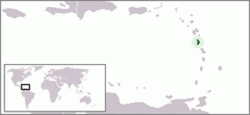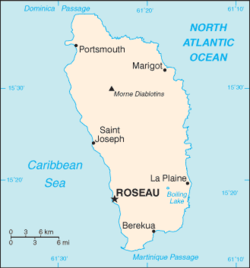Outline of Dominica
 From Wikipedia - Reading time: 9 min
From Wikipedia - Reading time: 9 min



The following outline is provided as an overview of and topical guide to Dominica:
Dominica – sovereign island nation located in the Caribbean Sea.[1] In Latin, its name means "Sunday", which was the day on which it was discovered by Christopher Columbus. Dominica's pre-Columbian name was Wai'tu kubuli, which means "Tall is her body".[2] The Carib Territory was established for the indigenous people of the island. Because the island lies between two French overseas departments, Guadeloupe to the north and Martinique to the south, and because it was colonized by France for a time, it is sometimes called "French Dominica". However, its official language is English, though a French creole is commonly spoken. Dominica has been nicknamed the "Nature Isle of the Caribbean" for its largely unspoiled natural environment. It is one of the youngest islands in the Lesser Antilles, still being formed by geothermal-volcanic activity, as evidenced by the world's second-largest boiling lake. The island features lush mountainous rainforests, home of many very rare plant, animal, and bird species. There are xeric areas in some of the western coastal regions, but heavy rainfall can be expected inland. The sisserou parrot, the island's national bird, is featured on the national flag. Dominica's economy is heavily dependent on both tourism and agriculture.
General Reference
[edit]
- Pronunciation: /ˌdɒmɪˈniːkə/ dom-i-NEE-kə
- Common English country name: Dominica
- Official English country name: The Commonwealth of Dominica
- Common endonym(s):
- Official endonym(s):
- Adjectival(s): Dominican
- Demonym(s):
- Etymology: Name of Dominica
- ISO country codes: DM, DMA, 212
- ISO region codes: See ISO 3166-2:DM
- Internet country code top-level domain: .dm
Geography of Dominica
[edit]- Dominica is: a country
- Location:
- Northern Hemisphere and Western Hemisphere
- North America (though not on the mainland)
- Atlantic Ocean
- Time zone: Eastern Caribbean Time (UTC-04)
- Extreme points of Dominica
- High: Morne Diablotins 1,447 m (4,747 ft)
- Low: Caribbean Sea 0 m
- Land boundaries: none
- Coastline: 148 km
- Northern Hemisphere and Western Hemisphere
- Population of Dominica: 67,000 - 195th most populous country
- Area of Dominica: 754 km2
- Atlas of Dominica
Environment of Dominica
[edit]
- Climate of Dominica
- Renewable energy in Dominica
- Geology of Dominica
- Protected areas of Dominica
- Wildlife of Dominica
Natural geographic features of Dominica
[edit]- Bodies of water
- Landforms
- World Heritage Sites in Dominica
Regions of Dominica
[edit]Ecoregions of Dominica
[edit]List of ecoregions in Dominica
Administrative divisions of Dominica
[edit]Municipalities of Dominica
[edit]- Capital of Dominica: Roseau
- Cities of Dominica
Demography of Dominica
[edit]Government and politics of Dominica
[edit]- Form of government: parliamentary representative democratic republic
- Capital of Dominica: Roseau
- Elections in Dominica
- Political parties in Dominica
Branches of the government of Dominica
[edit]Executive branch of the government of Dominica
[edit]- Head of state: President of Dominica, Nicholas Liverpool
- Head of government: Prime Minister of Dominica, Roosevelt Skerritt
- Cabinet of Dominica
Legislative branch of the government of Dominica
[edit]Judicial branch of the government of Dominica
[edit]Foreign relations of Dominica
[edit]International organization membership
[edit]The Commonwealth of Dominica is a member of:[1]
Law and order in Dominica
[edit]Military of Dominica
[edit]- Command
- Forces
- Military history of Dominica
- Military ranks of Dominica
Local government in Dominica
[edit]History of Dominica
[edit]Culture of Dominica
[edit]- Architecture of Dominica
- Cuisine of Dominica
- Festivals in Dominica
- Languages of Dominica
- Media in Dominica
- National symbols of Dominica
- People of Dominica
- Public holidays in Dominica
- Records of Dominica
- Religion in Dominica
- World Heritage Sites in Dominica
Art in Dominica
[edit]- Art in Dominica
- Cinema of Dominica
- Literature of Dominica
- Music of Dominica
- Television in Dominica
- Theatre in Dominica
Sports in Dominica
[edit]Economy and infrastructure of Dominica
[edit]- Economic rank, by nominal GDP (2007): 183rd (one hundred and eighty third)
- Agriculture in Dominica
- Banking in Dominica
- Communications in Dominica
- Companies of Dominica
- Currency of Dominica: Dollar
- ISO 4217: XCD
- Energy in Dominica
- Mining in Dominica
- Tourism in Dominica
- Transportation in Dominica
- Dominica Stock Exchange
Education in Dominica
[edit]Health in Dominica
[edit]See also
[edit]- All pages with titles beginning with Dominica
- All pages with titles containing Dominica
- All pages with titles beginning with Dominican
- All pages with titles containing Dominican
- Index of Dominica-related articles
- List of Dominica-related topics
- List of international rankings
- Member state of the Commonwealth of Nations
- Member state of the United Nations
- Outline of geography
- Outline of North America
- Outline of the Caribbean
References
[edit]- ^ a b "Dominica". The World Factbook. United States Central Intelligence Agency. July 3, 2009. Retrieved July 23, 2009.
- ^ "Discover Dominica: The Nature Island". Archived from the original on 2010-09-23. Retrieved 2010-06-27.
External links
[edit]- Commons: Dominica
- Official website of the Government of the Commonwealth of Dominica
 Dominica travel guide from Wikivoyage
Dominica travel guide from Wikivoyage- Discover Dominica: Nature Island of the Caribbean - Official government tourism website by the Discover Dominica Authority
 KSF
KSF